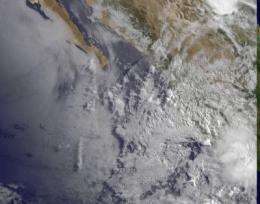Satellite video shows Tropical Storm Beatriz fizzle in 6 hours

Satellite data from NASA and NOAA showed that Tropical Storm Beatriz went from a strong tropical storm to a remnant low pressure area in six short hours after running into Mexico's western mountains. An animation of imagery from the GOES-11 satellite showed how quickly Beatriz fizzled.
The animation of imagery from the Geostationary Operational Environmental Satellite called GOES-11 was created by the NASA/NOAA GOES Project at NASA's Goddard Space Flight Center in Greenbelt, Md. It shows satellite imagery in 15 minute intervals from June 20 at 13:00 UTC (9 a.m. EDT/6 a.m. PDT) until June 22 at 1315 UTC (9:15 a.m. EDT/6:15 a.m. PDT) as Beatriz battered southwestern Mexico's coastline and weakened quickly.
GOES-11 captures imagery of weather over the western half of the U.S. continually, every day. GOES-11 is managed by NOAA and provides forecasters with visible and infrared imagery of weather systems.
According to reports from Agence-France Presse, Beatriz downed trees and left flooding in her wake. Coastal areas reporting flooding include Acapulco and Huatulco, in Oaxaca state.
At 5 p.m. EDT on June 21, Beatriz had maximum sustained winds near 60 mph, and as Beatriz interacted with the mountainous terrain of Mexico its strength waned quickly.
By 11 p.m. EDT the center of circulation was no longer well-defined and maximum sustained winds dropped to 30 mph. It was a quick drop in strength over six hours and transformed Beatriz from a strong tropical storm to a weak tropical depression. At that time her center was located near 19.0 North latitude and 107.0 West longitude and moving westward near 10 mph (17 kmh).
Today, June 22, Beatriz' remnants are slowly moving over cooler sea surface temperatures. As a result, the low pressure area has a slim chance of regenerating because temperatures of at least 80 degrees Fahrenheit are needed to maintain a tropical cyclone, and these waters are near or below that threshold.
As of 8 a.m. EDT today, Beatriz' remnants were about 175 miles southwest of Cabo Corrientes, Mexico. The National Hurricane Center noted today that the chance for regeneration is now "near zero."
Provided by NASA's Goddard Space Flight Center





















